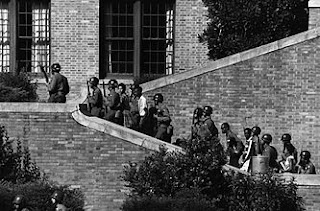So my part of our presentation on the NAACP wasn't the greatest. So here is a more coherent brief on the NAACP's work in the civil rights movement.
x
On May 17 1954, a NAACP legal team led by the associations chief counsel Thurgood Marshall, celebrated one of the greatest legal victories in the civil rights movement. The court found segregation in public schools to be unconstitutional in the federal case Brown v. Board of Education. (Thurgood Marshall later went to serve as the first African American appointed to the Supreme Court.)
During the Civil Rights movement the top leaders of the NAACP movement and black elites pushed for legal action to fight segregation. The association worked within the government, specifically the judiciary system, hiring grassroots lawyers to tackle the segregation case by case. This tactic was pushed by the association’s executive secretary, Roy Wilkins, who was worried that direct confrontation (such as protest) would result in an even stronger backlash from white supremacists.
While Brown V. Board of Education deemed segregation in public schools unconstitutional in 1954 integration took over a decade. 68% of black children in the south still attended all black schools in January of 1969. In response the NAACP filed hundreds of lawsuits on the local level, successfully integrating a host of schools. Unfortunately school integration was not without violence.
There was an instance in 1970 in South Carolina where a group of three buses carrying over 500 black students to be integrated into a new school were attacked by a mob of white protesters. Many of the children were injured by the incident and were able to take shelter in the school they were being taken to shortly before the mob overturned two of the buses. A group of NAACP leaders were soon after able to secure federal marshals to protect the students. This incident in 1969 is reminiscent of the little rock nine incident in 1957, only it had been twelve years and followed several years behind the civil rights acts in 1964 and 1968, as well as the Voting Rights act in 1965 (which were all helped into passage by NAACP lobbyist Clarence Mitchell). However the continued work of NAACP lawyers helped ensure successful integration of public schools as well as many other establishments that refused to serve, hire or allow people of color. The NAACP shows that use of the legal system is an extremely effective form of civil engagement and political activism. While protests and demonstrations do spread awareness from a cause and have the power to unite a group of citizens, the power of legality and of pressuring the government from within the government is undeniable. Shows that a citizen’s greatest power is to engage in politics on a local level.
The NAACP did still organize successful protests and demonstrations, but they were more successful in the north. The NAACP played a role in organizing the 1963 March on Washington, during which MLK gave his famous I have a dream speech.
Unlike many civil rights organizations in the south NAACP maintained strong membership after the mid 60s, when many other civil rights organizations simply disappeared. In fact NAACP was enormous by the mid 60s, having close to 450,000 members. The NAACP was so successful during this time period because of its strong consistent leadership, under Roy Wilkins, and its systematic approach at combating social and economic equality. The NAACP legal teams have been called the “crown jewel” of the NAACP and were crucial to the success of the civil rights movement.





No comments:
Post a Comment